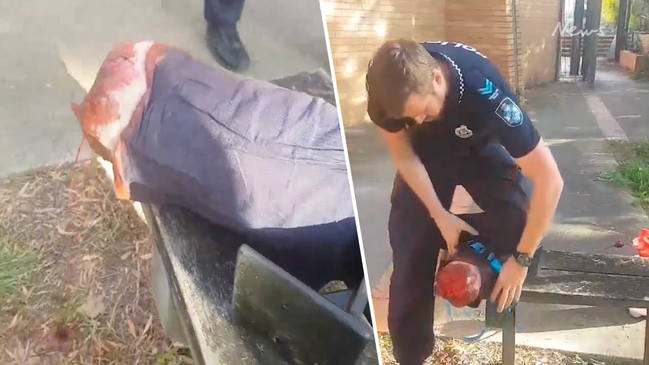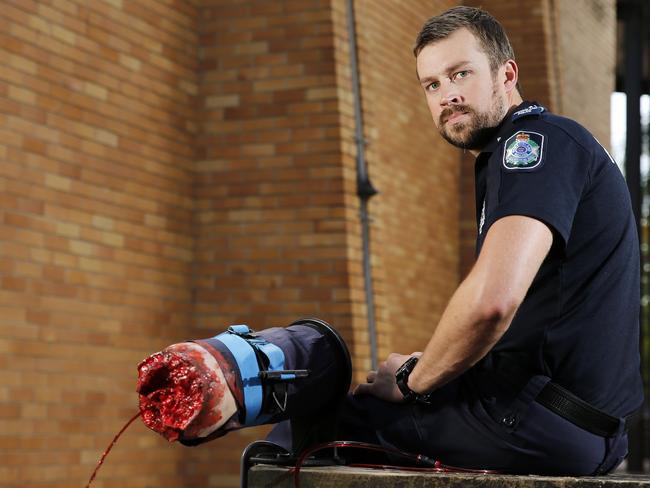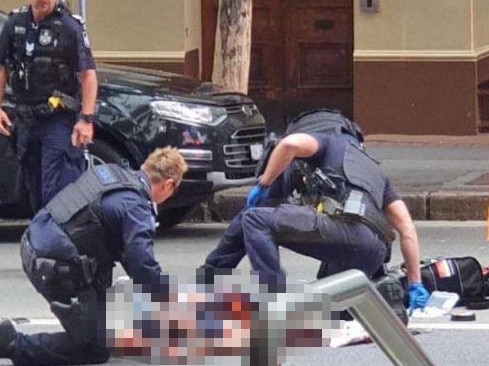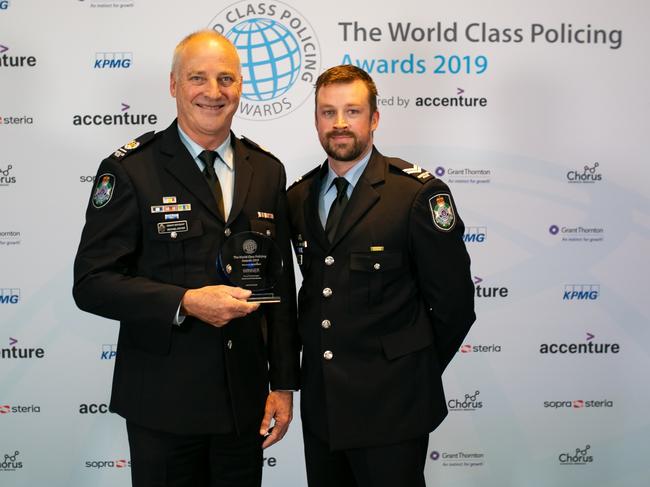Lives saved thanks to Queensland Police now undergoing award-winning tactical first aid training
Police are rapidly becoming life-savers when they arrive on scene to stabbing victims and car crash victims - thanks to the help of a training system previously reserved for the special forces.

QLD News
Don't miss out on the headlines from QLD News. Followed categories will be added to My News.
A STREAM of blood poured out of the thigh before police officer Dustin Osborne quickly applied pressure and wrapped a tourniquet around the amputated limb.
The few seconds it took stopped the rapid rush of blood from pouring out of the critical artery, possibly making the difference between life, death or more severe injuries before paramedics could arrive.
The realistic fake scenario, complete with amputated thigh prosthetic spurting red liquid, was just one part of a Tactical First Aid (TFA) training course about 11,000 operational Queensland Police officers now undergo each year.
Family continues fight for justice for missing police officer
Outback town wants senior police officers removed
Gold Coast police claim to be victims of witch hunt
Senior Constable Osborne, 36, from the Fortitude Valley Police Station, said at least 25 lives had been saved thanks to the tactical first aid training, which had been used by officers in about 100 situations since 2017.
“Before if we shot someone we could do nothing,” he said.
“We couldn’t because we didn’t have the skills and capabilities … that we do now.”

The TFA Project was developed in conjunction with Daryl Wall, then-director of the trauma service at the Royal Brisbane and Women’s Hospital, as well as the Queensland Ambulance Service and Australian Special forces medics.
Sen Constable Osborne and project partner Senior Sergeant Michael Dwyer, 58, said police officers were often first on the scene in everything from crime scenes to car crashes to attempted suicides or to those who sustain large haemorrhages in other ways.
“The training was more operationally practicable to police officers to better serve the community as well as to better protect themselves,” Snr Constable Osborne said.
“All police have the opportunity to attend the regular first aid course, but this is taking it to a higher level.
“We are focusing on life-threatening, traumatic injuries, including stabbing, gunshot wounds, injuries from explosive ordinances and traffic accidents.
“There are often crucial minutes to apply these things, so it’s good to now have the ability, skills, knowledge and now the resources to take immediate and effective action.”
Snr Constable Osborne said first the officers learn how to try to save limbs, torsos and how to correctly patch wounds from gunshots, stabbings or other situations like crashes before paramedics arrived.
In crime scene cases, paramedics were not permitted in to treat anyone until the scene was deemed safe enough by police.

A tactical first aid kit, containing a tourniquet, two chest seals and wound packing bandages, along with a set of shears, is then issued to the officer for their patrol vehicles.
Snr Constable Osborne said although some police officers had applied tourniquets when needed previously, they had to use whatever they could, such as their own belt.
Some of the first officers to go through the training in 2017 put their news skills to use on the job within a week of finishing their individual classes, for everything from a motorcycle crash to a stabbing to a plane crash.
Constable Melissa Shambrook, 29, did not ever expect to have to use a tourniquet to stem the flow of blood from a stab wound on anyone in Childers.
Yet, only three days after having completed the tactical first aid training courses in one of the first classes, that’s exactly what she had to do.
“We were called to a disturbance at a house in Childers,” she said.
“When we got there, there was a man who had sustained a stab wound to his left arm.
“The knife had gone right through the muscle to the other side.”
Senior Constable Josh Roberts and Constable Shambrook removed a towel from the victim’s arm before she retrieved the tactical first aid kit from the car, which contained items like a tourniquet, chest seals and wound packaging bandages.
Constable Shambrook said she packaged the stab wound with a bandage, then applied a tourniquet to stop the bleeding.
“The ambulance arrived about five minutes later,” she said.
The victim, 33, had been involved in a neighbourhood dispute at a rural property on Church Street, Horton about 4pm on August 18, 2017.

Constable Shambrook said, although officers were already trained in basic first aid, having the next level of training helped.
“The tactical first aid training is brilliant, it’s really good to have,” she said.
Snr Constable Osborne said the need for tactical first aid skills was borne following Active Armed Offender training in 2016 and was the brainchild of the Operational Skills section.
“I was part of the team that developed a ‘man down’ component of that course, to work out how to facilitate the recovery and retrieval of casualties, police officers and members of the public,” he said.
“So, in a formulation of that lesson plan, a lot of research was done into the types of trauma that are current.”
Dr Wall, who is also co-chairman of the Queensland Health State-wide Trauma Clinical Network, worked with Snr Constable Osborne to ensure the equipment and curriculum was suitable.
He said he worked with the police to ensure standard practices were followed.
“If a policeman puts on a tourniquet, they’ll identify what level of trauma, what time it was placed and if they made any adjustments in the tourniquet,” he said.
“That means we get the patient under the same standard of practice that we have at the hospital.
“The paramedics are, of course, the best in the world, but they may not be able to see the patient for an hour or so (such as at a crime scene).”
QAS Medical Director, Steve Rashford, was all for the police training.
“Any time there are injuries and police are on the scene, those extensions they’ve been taught to do are absolutely lifesaving,” he said.
The TFA Project was one of six international winners at the World Class Policing Awards in London in 2019.
Examples of the TFA training having come in use shortly after the first lot of officers completed the course in 2017:
GOLD COAST
A motorcyclist was riding south on the M1 at Reedy Creek when he crashed into the back of a van.
Robina Police Station Senior Constable David Hanna was heading home from work on his own motorcycle when he saw the leg of the other motorcyclist get severed due to the impact of the crash.
The victim’s body stopped about 70m away, next to the car of an off-duty trauma nurse, according to police.
The nurse, Snr Constable Hanna and another person started CPR but due to the blood rushing out of the man’s severed leg, it was difficult to maintain his blood pressure.
Snr Constable Hanna who had completed tactical first aid training only a week prior, was able to assist a paramedic fit a tourniquet after previous attempts using a belt failed.
The man survived.
Snr Constable Osborne said the officer now had tourniquets in his home and vehicles, and had taught his wife and children how to apply one.
SUNSHINE COAST
On the Sunshine Coast, four people were trapped inside a light aircraft with aviation fuel gushing from it following a joy flight gone wrong.
The Sling Four plane crashed in dirt near the Caloundra Aerodrome runway and ended up on its roof. The pilot and front passengers were trapped but the rear passengers were able to free themselves from the wreck.
Three police officers arrived before firefighters and paramedics reached the scene.
The officers, Senior Constable Andrew Devenney, Senior Constable Amanda Murphy and then-First Year Constable Morgan Dek from the Caloundra Police Station, were able to get inside the plane to help the firefighters and paramedics rescue and treat the trapped passengers.
A paramedic was having trouble placing a tourniquet on the pilot, due to not being able to reach past a steel structure frame, so Snr Constable Devenney, who was on the other side of the frame, was able to place it on for him.
He had completed the tactical first aid training a week earlier.
